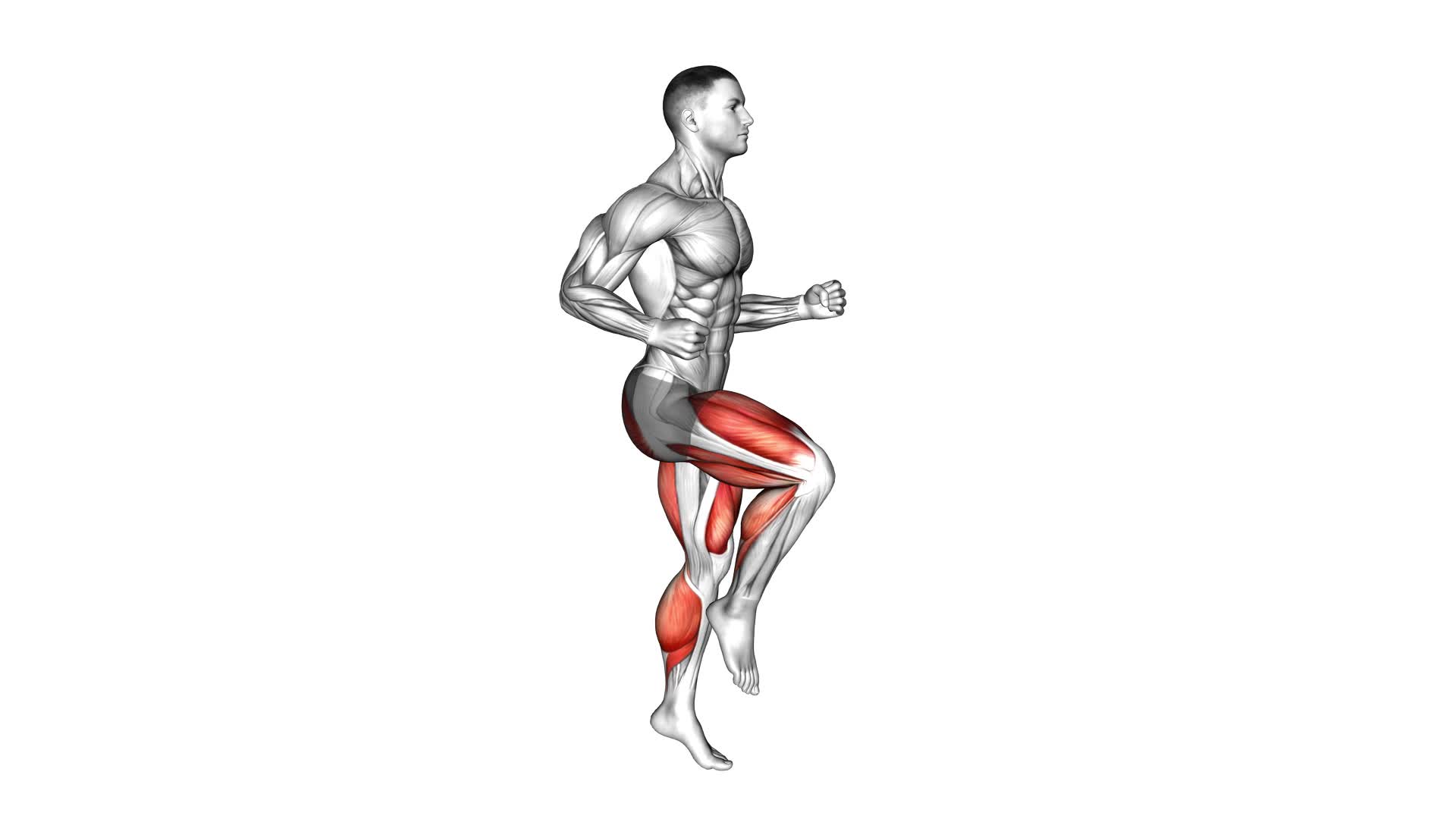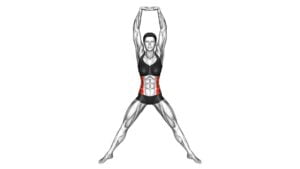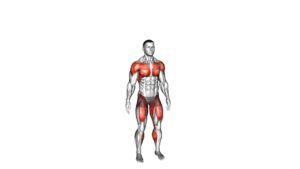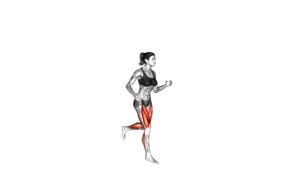Half Knee Bends (male) – Video Exercise Guide & Tips

Are you looking for a quick and effective lower body exercise? Look no further than half knee bends!
Watch This Exercise Video
This video exercise guide and tips will show you the proper technique for maximizing your results. Whether you're a beginner or advanced, there are modifications to suit your fitness level.
Incorporating half knee bends into your routine will help you strengthen and tone your legs. Get ready to feel the burn and see the results!
Key Takeaways
- Half Knee Bends improve lower body strength, core strength, and flexibility.
- Proper knee alignment is crucial to minimize stress on joints and prevent injuries.
- Engaging the proper muscles, such as glutes and quads, is important for effective half knee bends.
- Avoid common mistakes like letting knees go past toes or leaning too far forward to maximize results and prevent pain or injury.
Benefits of Half Knee Bends
To maximize the effectiveness of your workout, it's important to understand the benefits of incorporating half knee bends into your exercise routine. Half knee bends, also known as half squats, offer numerous benefits that can enhance your overall fitness and strength.
One of the key benefits of performing half knee bends is the improvement of lower body strength. By engaging your quadriceps, hamstrings, and gluteal muscles, half knee bends help to strengthen and tone these muscles, resulting in improved stability and balance. Additionally, half knee bends also target your core muscles, including your abdominal and lower back muscles, which play a crucial role in maintaining proper posture and preventing injuries.
Another advantage of incorporating half knee bends into your workout routine is their ability to enhance your flexibility. As you perform the exercise, your hip flexors, calves, and ankles are stretched, improving their range of motion. This increased flexibility can help to prevent muscle imbalances and reduce the risk of injuries during other exercises or daily activities.
Technique is crucial when performing half knee bends to reap their full benefits. Begin by standing with your feet shoulder-width apart. Lower your body by bending your knees and hips, keeping your back straight and chest lifted. Aim to lower until your thighs are parallel to the ground, and then return to the starting position. Remember to exhale as you push through your heels to stand up.
Incorporating half knee bends into your exercise routine can significantly improve your lower body strength, enhance flexibility, and contribute to overall fitness. By implementing the correct technique and performing the exercise correctly, you can maximize the benefits and achieve your fitness goals.
Proper Technique for Half Knee Bends
To perform half knee bends with proper technique, there are a few key points to keep in mind.
First, focus on maintaining proper knee alignment throughout the movement to minimize stress on the joints.
Engage your muscles by squeezing your glutes and quads, and avoid relying solely on momentum.
Lastly, be aware of common mistakes such as allowing your knees to cave in or leaning too far forward.
Knee Alignment Tips
For proper technique in half knee bends, focus on maintaining proper alignment of your knees with the help of a compound preposition. This is essential to ensure effective knee alignment exercises and knee strengthening exercises.
Here are three important tips to keep in mind:
- Keep your knees in line with your toes: Make sure that your knees are tracking directly over your toes throughout the entire movement. This helps to prevent any unnecessary strain on your knee joints.
- Avoid inward collapse of the knees: Be mindful of any inward collapse or caving in of the knees as you perform the exercise. This can put excessive stress on the knee joint and increase the risk of injury.
- Engage your core muscles: Maintain a strong core by activating your abdominal muscles. This provides stability to your spine and pelvis, which in turn helps to maintain proper knee alignment.
By following these knee alignment tips, you can ensure that you're performing half knee bends with proper technique and minimizing the risk of injury.
Now, let's move on to the next section about muscle engagement cues.
Muscle Engagement Cues
Now let's focus on engaging the relevant muscles to ensure proper technique for half knee bends. Proper muscle activation is essential for maximizing the benefits of this exercise and minimizing the risk of injury.
To engage the muscles correctly, start by gently squeezing your glutes and engaging your core. This will help stabilize your body and maintain proper alignment throughout the movement.
Additionally, focus on activating your quadriceps and hamstrings as you perform the half knee bends. Feel the muscles working as you lower yourself down and push back up.
If you notice any form corrections, such as your knees collapsing inward or your back rounding, make adjustments accordingly.
Common Mistakes to Avoid
When performing half knee bends, it's important to avoid common mistakes in order to maintain proper technique and maximize the benefits of the exercise. Here are three common mistakes to avoid:
- Allowing your knees to go past your toes: One common mistake is letting your knees extend too far forward during the movement. This can put unnecessary strain on your knee joints. To avoid this, focus on pushing your hips back and keeping your weight in your heels.
- Not maintaining a neutral spine: Another mistake is rounding or arching your back during the exercise. This can lead to lower back pain and decrease the effectiveness of the movement. Keep your core engaged and maintain a straight, neutral spine throughout the exercise.
- Failing to lower down to the appropriate depth: Many people make the mistake of not going low enough during the half knee bend. This limits the engagement of the muscles and reduces the benefits of the exercise. Aim to lower down until your thighs are parallel to the ground.
Common Mistakes to Avoid
To prevent injury and maximize the effectiveness of your half knee bends, it's important to be aware of common mistakes that you should avoid. These mistakes often lead to form breakdowns, reducing the benefits of the exercise and increasing the risk of injury.
One common mistake is failing to maintain proper alignment. When performing half knee bends, your knees should be in line with your toes, and your back should be straight. Avoid letting your knees collapse inward or leaning too far forward, as this can strain your knees and back.
Another mistake to watch out for isn't engaging your core muscles. Your core helps stabilize your body during the exercise, so make sure to activate it by pulling your belly button towards your spine.
Additionally, avoid rushing through the exercise and sacrificing proper form for speed. Instead, focus on controlled movements, lowering yourself down and coming back up slowly.
Lastly, be mindful of not overloading your body with excessive weight. Start with lighter weights and gradually increase as your strength improves.
Tips for Maximizing Your Results
To further enhance your results, how can you optimize your technique while performing half knee bends? Here are three form improvement tips that will help you maximize gains:
- Maintain proper alignment: Ensure that your knees are aligned with your toes throughout the movement. This will help prevent unnecessary strain on your knees and promote better muscle activation in your lower body.
- Engage your core: Remember to engage your core muscles by pulling your belly button in towards your spine. This will help stabilize your body and maintain good posture, allowing you to perform the exercise with greater control and efficiency.
- Control your descent: Focus on a slow and controlled downward movement during the exercise. Avoid simply dropping down and bouncing back up. By controlling your descent, you engage your muscles for a longer duration, leading to increased muscle activation and better results.
By following these form improvement tips, you can optimize your technique and maximize gains from your half knee bends. Remember to listen to your body, start with lighter weights if necessary, and gradually increase the intensity as you progress.
Happy exercising!
Modifications for Beginner and Advanced Levels
Let's talk about modifications that can be made for both beginners and advanced individuals during the half knee bends exercise.
For beginners, there are progressions that can be implemented to gradually build strength and improve technique.
On the other hand, advanced individuals can challenge themselves by incorporating more advanced modifications to further enhance their workout and continue progressing.
These modifications cater to different fitness levels and allow individuals to tailor the exercise to their specific needs and goals.
Beginner Progressions for Modifications
You can modify half knee bends for beginners by using an article determiner to indicate the specific modifications for different levels of experience. Here are three progressive modifications that beginners can use to build strength and stability:
- Partial Range of Motion: Start by performing half knee bends within a comfortable range of motion. Gradually increase the depth of the bend as you gain strength and flexibility.
- Bodyweight Support: If you struggle with balance or lack lower body strength, use a chair or wall for support. Hold onto the chair or place your hands on the wall for balance while performing the half knee bends.
- Tempo Control: Slow down the movement to focus on proper form and muscle activation. Perform the half knee bends at a controlled pace, emphasizing the lowering phase to engage the muscles effectively.
Advanced Modifications for Challenge
To further enhance the difficulty level and provide a challenge for both beginners and advanced individuals, there are additional modifications that can be incorporated into half knee bends.
These advanced modifications are designed to increase the difficulty levels and push your limits.
One modification is to hold a dumbbell in each hand while performing the exercise. This added weight increases the resistance and forces your muscles to work harder.
Another advanced modification is to perform the half knee bends on an unstable surface, such as a balance board or Bosu ball. This challenges your stability and engages more muscles to maintain balance.
Additionally, you can try performing the half knee bends at a slower tempo, focusing on controlling the movement and increasing time under tension.
These advanced modifications will take your half knee bends to the next level and help you achieve greater strength and stability.
Incorporating Half Knee Bends Into Your Fitness Routine
Incorporate half knee bends into your fitness routine for improved lower body strength and stability. These exercises are a great addition to any workout regimen, whether you're a beginner or an advanced fitness enthusiast.
Here are three ways you can incorporate half knee bends into your routine:
- Half knee bend variations: There are several variations of the half knee bend that you can try to target different muscles in your lower body. You can add weights to increase the intensity or perform the exercise on an unstable surface, such as a Bosu ball, to challenge your balance and stability.
- Incorporating half knee bends into a HIIT workout: High-intensity interval training (HIIT) is a popular workout style that combines short bursts of intense exercise with periods of rest. You can include half knee bends in your HIIT routine by performing them for a set amount of time, followed by a brief rest period. This will help elevate your heart rate and burn more calories.
- Progressive overload: To continue seeing progress and improvements in your lower body strength and stability, it's important to gradually increase the difficulty of your half knee bend exercises. This can be done by adding more repetitions, increasing the weight, or performing the exercise at a slower pace.
Frequently Asked Questions
How Many Repetitions of Half Knee Bends Should I Do in One Set?
To determine how many repetitions of half knee bends you should do in one set, it's important to focus on proper form and technique.
Half knee bends, also known as squats, are a great exercise for strengthening your lower body. Start with a comfortable number of reps, such as 10-12, and gradually increase as you become more comfortable and stronger.
Remember to maintain good posture and engage your core throughout the exercise. Variations and modifications exist for different fitness levels, so adjust accordingly.
Can Half Knee Bends Help Improve Knee Stability?
Half knee bends can be a great way to improve knee stability and strengthen your knees. By performing this exercise, you can work on the muscles around your knees, which can help support and stabilize your joints.
The benefits of half knee bends include increased knee strength and improved balance. Incorporating this exercise into your fitness routine can be beneficial for anyone looking to improve their knee stability and overall lower body strength.
Is It Normal to Feel a Burning Sensation in the Thighs During Half Knee Bends?
Feeling a burning sensation in your thighs during half knee bends isn't unusual. It can happen if you're pushing yourself too hard or not using proper form. Make sure to engage your core, keep your back straight, and lower yourself down slowly.
If the burning sensation persists or becomes too intense, it's important to listen to your body and take a break. Remember, proper form is crucial for preventing injuries and getting the most out of your workout.
Can Half Knee Bends Help With Improving Balance?
Half knee bends can certainly improve your balance. By engaging your core muscles, these exercises help stabilize your body and strengthen your lower body muscles. This increased stability and strength can greatly benefit your overall balance.
Additionally, half knee bends are often used by athletes to enhance their athletic performance. The controlled movements and focus required in this exercise can improve coordination and stability, leading to better balance during various sports activities.
Are Half Knee Bends Suitable for People With Knee Injuries or Arthritis?
Half knee bends may not be suitable for people with knee injuries or arthritis. If you have a knee injury, there are alternative exercises you can do to help with rehabilitation.
It's important to take precautions when performing half knee bends with arthritis. Make sure to listen to your body and stop if you experience any pain or discomfort.
Consulting with a healthcare professional or physical therapist can provide you with personalized advice and guidance.
Conclusion
In conclusion, half knee bends are a beneficial exercise for both beginners and advanced individuals looking to strengthen their lower body muscles.
By following the proper technique and avoiding common mistakes, you can maximize your results and prevent injury.
Whether you're a beginner or advanced, there are modifications available to suit your fitness level.
Incorporating half knee bends into your fitness routine can help improve your overall strength and stability.

Author
Years ago, the spark of my life’s passion ignited in my mind the moment I stepped into the local gym for the first time. The inaugural bead of perspiration, the initial endeavor, the very first surge of endorphins, and a sense of pride that washed over me post-workout marked the beginning of my deep-seated interest in strength sports, fitness, and sports nutrition. This very curiosity blossomed rapidly into a profound fascination, propelling me to earn a Master’s degree in Physical Education from the Academy of Physical Education in Krakow, followed by a Sports Manager diploma from the Jagiellonian University. My journey of growth led me to gain more specialized qualifications, such as being a certified personal trainer with a focus on sports dietetics, a lifeguard, and an instructor for wellness and corrective gymnastics. Theoretical knowledge paired seamlessly with practical experience, reinforcing my belief that the transformation of individuals under my guidance was also a reflection of my personal growth. This belief holds true even today. Each day, I strive to push the boundaries and explore new realms. These realms gently elevate me to greater heights. The unique combination of passion for my field and the continuous quest for growth fuels my drive to break new ground.







